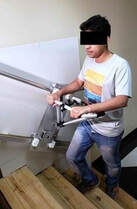 RailBot
RailBot
When a robot is used to enhance the stability or partially "carry" a human user in walking, the robot's own stability is an important factor. The interaction force applied by the human user may destabilize the robot and cause the robot to tip over. This problem is especially challenging in stair ascent/descent. Elevators and stairlifts are usually too expensive and bulky to be used in multi-story homes. Wheeled assistive devices are impractical to use on stairs. Legged robots may be able to go up and down stairs through advanced gait planning and motion control. However, providing assistance along the way may be overly demanding and risky. To this end, stair-climbing wheelchairs may be the only successful assistive technology on the market, but their practicality and usefulness are affected by the excessive weight and cost associated with the complex mobility mechanisms (reconfigurable wheels or tracks). Further, stair-climbing wheelchairs also suffer from a number of problems common among powered wheelchairs: heavy and bulky, difficult to maneuver in home environments, and the users’ lack of muscle use and bone load-bearing (which affects their long-term health).
The novel rail-sliding robot developed by our group, namely RailBot, provides stair-climbing assistance in a fundamentally different way. RailBot is essentially a powered rail-sliding platform that assists its user through a unique human interface. Unlike elevators, stair lifts, or powered wheelchairs, the RailBot does not carry or lift its users upstairs. Instead, it provides powered assistance (a gentle pulling force) and protection (through a safety belt) to help users climb stairs in an easier and safer way. Such fundamental change in assistance mode generates two significant advantages. First, the weight and size of the device can be substantially reduced, making it possible to obtain a compact, lightweight, and low-cost assistive device that can be easily installed and deployed in older adults’ homes. Such advantage is highly beneficial for promoting the acceptance and adoption of this novel assistive technology in the target population. Second, by assisting the users’ stair climbing instead of carrying them upstairs, the RailBot enables and encourages the users to maintain and enhance their stair-climbing capabilities. As stair climbing comes with a high requirement for muscle strength and full-body coordination, it has the potential of becoming a novel and effective mode of physical exercise to keep older adults physically active and improve their mobility. The long-term health benefits may be significant.
The novel rail-sliding robot developed by our group, namely RailBot, provides stair-climbing assistance in a fundamentally different way. RailBot is essentially a powered rail-sliding platform that assists its user through a unique human interface. Unlike elevators, stair lifts, or powered wheelchairs, the RailBot does not carry or lift its users upstairs. Instead, it provides powered assistance (a gentle pulling force) and protection (through a safety belt) to help users climb stairs in an easier and safer way. Such fundamental change in assistance mode generates two significant advantages. First, the weight and size of the device can be substantially reduced, making it possible to obtain a compact, lightweight, and low-cost assistive device that can be easily installed and deployed in older adults’ homes. Such advantage is highly beneficial for promoting the acceptance and adoption of this novel assistive technology in the target population. Second, by assisting the users’ stair climbing instead of carrying them upstairs, the RailBot enables and encourages the users to maintain and enhance their stair-climbing capabilities. As stair climbing comes with a high requirement for muscle strength and full-body coordination, it has the potential of becoming a novel and effective mode of physical exercise to keep older adults physically active and improve their mobility. The long-term health benefits may be significant.

